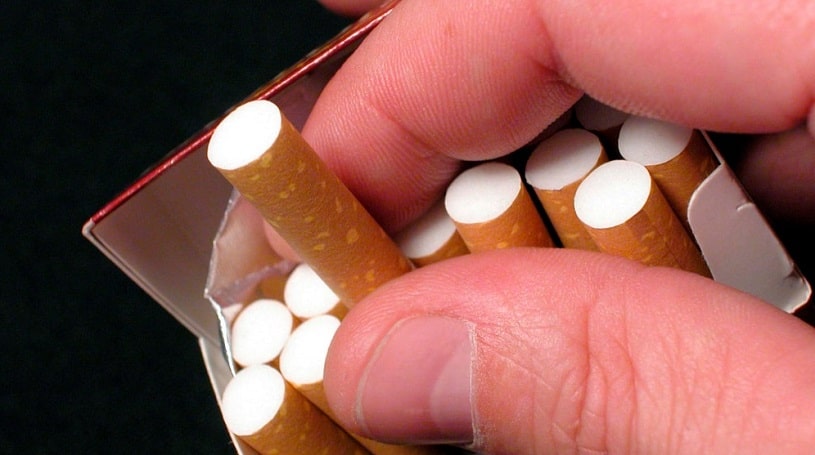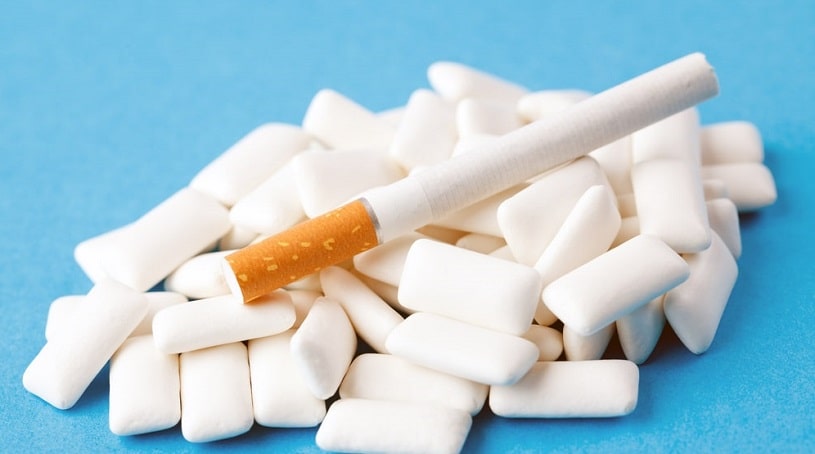Tobacco is the most abused drug in the US and the most widespread addiction people try to free themselves of. There are different treatments and methods available for those wondering how to quit smoking, each with different success rates depending on what plan suits the individual. Let’s take a look at the benefits of quitting smoking, how to quit smoking ways, types of NRT, useful tips for quitting smoking, and how to find help for addiction.
Table Of Contents:
Benefits Of Quitting Smoking
The first step towards a smoking-free life is a decision to quit. Making the decision to quit smoking is the first and most important thought that a smoker can have in the journey towards better health. Studies have shown that the chances of having a stroke are reduced almost to half within two years of quitting. Moreover, smoking cessation will help get rid of unpleasant nicotine side effects and improve one’s overall health.

Apart from lower chances of a stroke, there are many other health benefits of quitting smoking.
Some Of them Include:
- The risk of heart disease is tremendously reduced after quitting
- Blood pressure and heart rate also reduce after quitting
- Reduced risk of lung cancer and other cancers such as throat cancer, esophageal cancer, colon cancer, cervical cancer, and so on
- The chances of getting certain other health conditions such as asthma, gum disease, diabetes, and vision loss are also reduced after quitting smoking
Smoking may also be a source of conflict among your family and friends, so quitting has social benefits too. However, many people may find smoking cessation hard. They find themselves in situations where they fall back into tobacco use or are unable to continue on the road to quitting within a few days of trying. In such cases, professional drug rehab can prove to be highly beneficial and improve success rates.
Ways To Quit Cigarettes
Smoking is so hard to quit because of the nicotine contained in cigarettes. Nicotine is highly addictive, and when consumed for a long time, the body develops both psychological and physical addiction. Physical addiction can be especially distressing as this leads to withdrawal symptoms upon cessation of the drug. Nicotine half-life is only around 2 hours, which means the withdrawal will start very quickly. Therefore you must know how to quit smoking. Some people think that switching to e-cigarettes can be helpful in quitting the habit, however, vaping is dangerous, and it contains the addictive substance too. Therefore, e-cigarettes can’t be considered a safe or effective option in terms of addiction treatment.

Some of the methods to help a person quit include NRT, which involves taking the substance in any way besides tobacco. This includes the use of gums, lozenges, patches, nose sprays, and so on. Another popular option is abrupt smoking cessation. This method is called “cold turkey” and can be quite uncomfortable. The final and most effective option is getting addiction treatment in a drug rehab center.
Nicotine Replacement Therapy
Nicotine replacement therapy is a treatment designed to help people quit smoking by offering alternative sources of the substance besides tobacco. Nicotine replacement therapies (NRT) is the most popularly advertised treatment plan, claimed by the US government to take the best effect in smoking cessation when used with behavioral therapies. Different products are involved in quitting, which provides the substance of abuse in small amounts that are better for your health. The prime objective of nicotine replacement therapy is to ease the withdrawal symptoms, decrease nicotine cravings and eventually wean the individual off tobacco entirely.
A remarkable health benefit of NRT is that, unlike cigarettes, they do not contain tar, tobacco, ammonia, carbon monoxide, and other toxic chemicals that harm one’s body.
Nicotine Patches
Nicotine patches are worn on the skin so that the body can absorb the drug from them. Patches are a continuous process that can last up to 24 hours. The patch is available in three sizes, the biggest one being 15 or 25mg, which is a 16-hour patch and should be used only during the day. A 21mg is a 24-hour patch and can be utilized during the day and overnight. Furthermore, the third type of patch is the pre-quit patch designed to help one prepare for the quitting process two weeks before starting the nicotine replacement therapy.

Nicotine Gums or Lozenges
Gums and lozenges which contain are available without a prescription and are also a popular form of NRT. Some individuals prefer gum or lozenges to the patches because it allows them to control the dose of the drug. Here is some healthy information on how to use this form of NRT. Chew the gum slowly and then store it against your cheek to be slowly absorbed. Do not use more than 20 pieces in a day. Avoid taking it with other stimulants or beverages such as tea, coffee, soft drinks, and acidic drinks. The ultimate goal is to stop taking the drug by 12 weeks.
Nicotine Inhaler
The nicotine inhaler requires a prescription in the US. Insert a nicotine cartridge into the plastic cigarette holder and smoke it like a cigarette for about 20 minutes. It is absorbed faster than patches and almost as quickly as lozenges or gum. One is expected to do this up to 16 times a day. This method helps satisfy the oral urges. Also, most of the vapor does not make it to the lungs, allowing you to slowly reduce your nicotine intake.
Nicotine Nasal Spray
The nicotine nasal spray can also only be obtained with a prescription. It helps provide an immediate dose of nicotine. This is due to the high vascularization of the nasal cavity, allowing the drug to be quickly absorbed. The effects can be noticed within 5-10 minutes. The spray is generally used 1-2 times an hour, not more than 80 times a day. The spray should not be used for longer than 6 months.
Side Effects Of NRT
Unfortunately, even NRT has some adverse health effects, especially when taken at high doses. Some of these include headaches, nausea, and transient insomnia. Nicotine replacement therapy should not be used by pregnant women or individuals with unhealthy cholesterol levels. Smoking while on NRT is dangerous as it increases the risk of nicotine poisoning.

Even though NRT is very effective at treating physical addiction, which manifests as withdrawal symptoms, it doesn’t do much in the way of psychological dependence, which manifests as cravings and drug-seeking behaviors. Another issue lies in the fact that it is possible to become addicted to the various forms of NRT. One way of treating addiction to NRT is to slowly phase out the drug by reducing the dose over time.
Nicotine Treatment In Rehab
Even with NRT, many people find it hard to entirely quit without the proper support and help from professionals. Therefore they can seek medical help in drug rehabilitation clinics. While it may be challenging to find rehab centers that only treat nicotine dependence, most rehab centers are well-equipped to deal with chemical dependencies such as nicotine addiction. While inpatient treatment may be necessary in extreme cases, outpatient treatment has proven to be effective in treating nicotine addiction.
These facilities and others will operate differently, but an outpatient program begins with a detox stage. It is like quitting cold turkey, but with medical staff to watch a patient during this process and provide support with the withdrawal symptoms. This can be the hardest part for many, but when it is over, the counseling phase of the recovery begins. In this, the body will be denied any and all nicotine (no patches are gum), and talk therapy will help one understand their addiction and get through it.
When a Person Enters Rehab, the Usual Process Of Enrollment Includes the Following Steps:
- The initial assessment is carried out, and all relevant information is gathered.
- An individualized cigarette detox and treatment plan are then created for each client to determine which medications and therapies will be most effective.
- Different therapies and medications are then administered during the treatment period, along with all the supplementary therapies.
Tips To Quit Smoking
Whether an individual decides to quit smoking on their own or with a rehabilitation center’s help, there are several useful tips to help fight nicotine cravings and fight the behavioral aspect of addiction to improve one’s health.
Here Are Some Useful Tips To Quit Smoking:
- Having a definite reason for wanting to quit, such as health or family, can serve as a significant motivator during the journey.
- Avoid alcohol and other triggers. Triggers may also be things such as non-alcoholic beverages or habits related to smoking, such as smoking while going for an evening walk.
- Get rid of every item at home that reminds of smoking, such as the sight of ashtrays or the smell of cigarette smoke. It may even involve you changing your wardrobe or getting new upholstery at home.
- Get active and eat healthier. It helps deal with the cravings and improves your overall health, encouraging you to quit smoking. Start an exercise plan, pick up a healthy diet and rid your home of any meals you usually take while smoking.
- Consider prescription medication, NRT, and even a rehabilitation plan as other viable methods of quitting.
- Prepare yourself before going "cold turkey" as this can be an especially distressing way of becoming nicotine-free. Search for healthy information on how to deal with the withdrawal symptoms that come with suddenly smoking cessation.
- Find a support group that can help you deal with the addiction. It may be your family, friends, or even groups like nicotine anonymous.
How to Find Help With a Smoking Addiction
Quitting smoking is no easy task, but it’s certainly possible. It requires determination, medications that help you to deal with the physical and psychological components of nicotine addiction, a structured recovery plan, and a strong support system, which may be your family, friends, or nicotine anonymous. That is why the initial process is best not done at home. A drug rehabilitation program offers you the tools you need to successfully free yourself of the addiction and healthy information on how to avoid relapsing once you integrate yourself back into that real world. It may include medications, behavioral techniques, and support groups which will help successfully break free from smoking addiction and drastically improve your long-term health.
Hope Without Commitment
Find the best treatment options. Call our free and confidential helpline
Most private insurances accepted
Page Sources
- Comparative efficacy of 24-hour and 16-hour transdermal nicotine patches for relief of morning craving. S Shiffman, C A Elash, S M Paton, C J Gwaltney, J A Paty, D B Clark, K S Liu, M E Di Marino. August 2000. https://pubmed.ncbi.nlm.nih.gov/11092066/
- Center for Disease Control and Prevention. Smoking and Tobacco Use. April 2020. https://www.cdc.gov/tobacco/basic_information/health_effects/index.htm
- Motivating and Helping Smokers to Stop Smoking. John R Hughes, MD. December 2003. https://www.ncbi.nlm.nih.gov/pmc/articles/PMC1494968/
- Do Drinking and Smoking Go Together? Saul Shiffman, Ph.D. and Mark Balabanis. 1996. https://www.ncbi.nlm.nih.gov/pmc/articles/PMC6876501/
- U.S. National Library of Medicine. MedlinePlus. Nicotine Replacement Therapy. https://medlineplus.gov/ency/article/007438.html
- Smokefree.gov. Fighting Cravings With Exercise. https://smokefree.gov/challenges-when-quitting/cravings-triggers/fight-cravings-exercise
- Smokefree.gov. Eat Healthy. https://smokefree.gov/stay-smokefree-good/eat-healthy
- American Cancer Society, Health Benefits of Quitting Smoking Over Time, 2020. https://www.cancer.org/healthy/stay-away-from-tobacco/benefits-of-quitting-smoking-over-time
- Smokefree, Benefits of Quitting, https://smokefree.gov/quit-smoking/why-you-should-quit/benefits-of-quitting
- Centers for Disease control and prevention, Learn About Nicotine Replacement Therapy, 2021. https://www.cdc.gov/tobacco/campaign/tips/quit-smoking/guide/explore-medications.html

 Authored by
Authored by  Reviewed by
Reviewed by 
